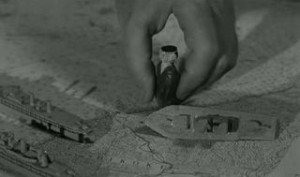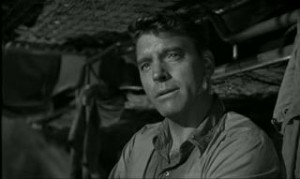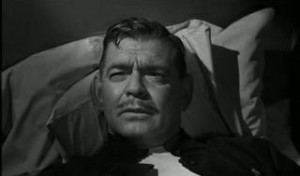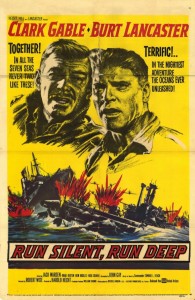Gable and Lancaster make the seas boil in the battle adventure that hits like a torpedo!
Run Silent Run Deep is one of the best films [intlink id=”280″ type=”category”]Clark Gable[/intlink] made following his return from World War II, and one of the great submarine movies. Destination Tokyo comes to mind as a film of equal merit, and with a similar theme, but made during the war. Released a good decade after the war, Run Silent Run Deep isn’t hampered by the propaganda and Japanese paranoia of its 1943 counterpart.
Gable made three other WWII movies after 1945, of varying quality. Betrayed (1954), an uninspired melodrama, is the worst, and Homecoming (1948), a medical team in the war zone, is not much better, both with [intlink id=”1490″ type=”category”]Lana Turner[/intlink]. By contrast, Command Decision, also 1948, is top-notch, the actor a bomber wing commander in England, a precursor of the superior Twelve O’Clock High released the next year, with [intlink id=”187″ type=”category”]Gregory Peck[/intlink] enduring similar pressures and conflicts.
During all this time, from 1945 to his death in 1960, Clark Gable was trying to continue his pre-war image as the male half of a romantic pair. His name alone garnered the loveliest ladies of the time—[intlink id=”277″ type=”category”]Ava Gardner[/intlink], Sophia Loren, [intlink id=”492″ type=”category”]Deborah Kerr[/intlink], Greer Garson, [intlink id=”38″ type=”category”]Marilyn Monroe[/intlink], to name a few—but the age difference was at times more than a little ridiculous. He had aged less gracefully than, say, [intlink id=”448″ type=”category”]Cary Grant[/intlink], who had a similar problem, and when Gable was cast opposite the likes of Doris Day and Carroll Baker, twenty-four and thirty years younger, he was pushing the envelope.
Grant had solved his difficulty by dropping out of films while still on top, living a useful life for another twenty years. Gable’s exit was unscheduled and premature. He died of a heart attack soon after finishing The Misfits and a few months before his fifth wife, Kay Williams, gave birth to his only child, John Clark Gable, discounting the girl he fathered with Loretta Young during the making of The Call of the Wild (1935).
While filming The Misfits, the actor had commented, “This is the best picture I have made, and it’s the only time I’ve been able to act.”
 In Run Silent Run Deep, he is in top form. If a little old (56) to be a submarine commander again, Commander “Rich” Richardson (Gable) has been demoted to a desk job. Everyday for over two hundred days he and his yeoman aide Mueller (Jack Warden) have re-enacted sinking the Japanese destroyer the “Akikaze”—on his desk top with four-inch models. The bitter and resentful Richardson, when he had commanded his last sub, had failed to sink that vessel, being sunk himself, and, now, comes news that another sub has been lost in the same area, the Bungo Straits.
In Run Silent Run Deep, he is in top form. If a little old (56) to be a submarine commander again, Commander “Rich” Richardson (Gable) has been demoted to a desk job. Everyday for over two hundred days he and his yeoman aide Mueller (Jack Warden) have re-enacted sinking the Japanese destroyer the “Akikaze”—on his desk top with four-inch models. The bitter and resentful Richardson, when he had commanded his last sub, had failed to sink that vessel, being sunk himself, and, now, comes news that another sub has been lost in the same area, the Bungo Straits.
 The commander, however, has been using his influence to be assigned another sub, and has selected “the best exec I could possibly get in the whole Navy,” a Lieutenant Jim Bledsoe ([intlink id=”315″ type=”category”]Burt Lancaster[/intlink]). Bledsoe was to have captained that very sub and understandably is upset to be demoted to second in command. Face to face with Richardson in his front yard, he requests a transfer, which his new boss denies.
The commander, however, has been using his influence to be assigned another sub, and has selected “the best exec I could possibly get in the whole Navy,” a Lieutenant Jim Bledsoe ([intlink id=”315″ type=”category”]Burt Lancaster[/intlink]). Bledsoe was to have captained that very sub and understandably is upset to be demoted to second in command. Face to face with Richardson in his front yard, he requests a transfer, which his new boss denies.
Aboard the sub are a crew of familiar supporting actors, including Warden, Brad Dexter, Joe Maross, Rudy Bond, Eddie Foy III and Don Rickles in his first movie role. Also there’s Nick Cravat as a galley sailor, Russo, whose job is to throw the garbage overboard, a plot-defining event. Cravat was Lancaster’s one-time circus partner and bit player in a number of Burt’s other films, i.e., The Flame and the Arrow, The Crimson Pirate, The Scalphunters and The Island of Dr. Moreau.
Commander Richardson has the crew repeat an unorthodox practice drill. The sub goes into an emergency dive, levels off at fifty feet and simulates torpedo release. He wants this maneuver done in thirty-five seconds; after many dives, the crew do it in thirty-one. When Richardson avoids a Japanese sub, he’s seen as a coward by the officers and men, who wonder, then, the purpose of it all. “Obedience? Efficiency?” Bledsoe asks. “Or the best drilled cowards in the Navy?” Against a Japanese warship the drills become reality, the men realizing that it was a close bow shot Richardson was after—two “fish” into the bow of the enemy, with devastating effect.
 During a depth charge attack in the Bungo Straits, Richardson suffers a concussion and Lieutenant Bledsoe assumes command. While in and out of consciousness in his bunk, Richardson hears what everyone else aboard is hearing—an unusual “beeping” sound. The words of the sonar man, “I can’t make that out,” echo in the injured man’s head. So, that’s the reason all attempts to get the “Akikaze” failed: there was an undetected Japanese sub in the channel!
During a depth charge attack in the Bungo Straits, Richardson suffers a concussion and Lieutenant Bledsoe assumes command. While in and out of consciousness in his bunk, Richardson hears what everyone else aboard is hearing—an unusual “beeping” sound. The words of the sonar man, “I can’t make that out,” echo in the injured man’s head. So, that’s the reason all attempts to get the “Akikaze” failed: there was an undetected Japanese sub in the channel!

I agree with your analysis: “The focal point is the charisma between the two officers, actually the well-tooled animosity and resentment.” That’s interesting that Gable and Lancaster didn’t get along when the movie was made. Ironically, it may have benefited the film. The younger Bledsoe is contemptuous of the older and more experienced Richardson. It is a timeless theme that the younger generation often thinks it knows more than the older generation. I wrote a short post on Run Silent Run Deep called “Honor vs Dishonor.” Here is the link if you would like to read it: https://christopherjohnlindsay.wordpress.com/2015/10/04/run-silent-run-deep/